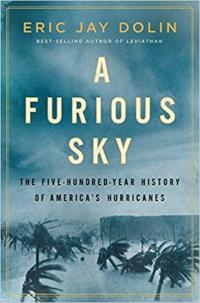 Having grown up on the Gulf Coast of Florida, I can say without hesitation that a hurricane is the most magnificent and absolutely the most terrifying of all events in nature. Recently NOAA announced that their Atlantic forecast is for an “extremely active” 2020 hurricane season, with 19-25 named storms and 3-6 major hurricanes. So, Eric Jay Dolin’s new book, A Furious Sky, the Five-Hundred-Year History of America’s Hurricanes is indeed most timely.
Having grown up on the Gulf Coast of Florida, I can say without hesitation that a hurricane is the most magnificent and absolutely the most terrifying of all events in nature. Recently NOAA announced that their Atlantic forecast is for an “extremely active” 2020 hurricane season, with 19-25 named storms and 3-6 major hurricanes. So, Eric Jay Dolin’s new book, A Furious Sky, the Five-Hundred-Year History of America’s Hurricanes is indeed most timely.
Dolin’s history of American hurricanes begins with Columbus’ fourth and last voyage to the Americas. Like other Europeans, Columbus arrived in the “New World” without even knowing the word hurricane.
On his previous voyages, Columbus had encountered severe storms and had heard of far worse meteorological monsters from the indigenous Taino natives. They called the giant storms juracan. The Taino also taught Columbus how to read the signs of an impending juracan.
When Columbus arrived at Santo Domingo on the island of Hispaniola with four small ships in 1502, he requested that his small fleet be allowed to shelter in the harbor. He also recommended to the governor that a much larger homeward-bound fleet to Spain delay its sailing because a big storm was on its way. Columbus saw all the signs of a juracan. Both his request and his recommendation were denied. Columbus, a better mariner than diplomat, found a sheltered cove where his ships would ride out the hurricane. The homeward-bound fleet would not fare as well, losing 24 ships, with only one of the original ships making it finally back to Spain.
Rather than being lauded for his seamanship, Columbus was accused of sorcery for conjuring up the mighty wind.
Dolin’s fascinating book traces our slow growth in understanding of hurricanes, from sorcery to science, alternating between accounts of hurricanes, whose buffeting literally changed history, with a narrative of how the scientists, politicians, and the press, all tried to cope with these massive storms.
While hurricanes ravaged the Americas for hundreds of years, Benjamin Franklin was among the first to realize, in the early1740s, that a hurricane had forward motion and yet the storm’s winds could blow contrary to the direction that it was moving. At about the same time, John Winthrop, a professor at Harvard, noted that atmospheric pressure as measured by a barometer dropped as a hurricane passed and that the lower the pressure dropped, the stronger the storm.
Almost a hundred years later in 1832, William Redfield, a merchant who owned a general store and saddlers shop, and also an avid amateur meteorologist, published a paper suggesting that hurricanes were giant whirlwinds. Others had made the observation before, but Redfield backed it with prodigious data.
Redfield’s work was generally well-received. His primary critic was James P. Espy, a scientist who argued that hurricanes were formed by warm moist ocean air rising rapidly, causing the barometer to fail and the winds to strengthen.
The two men debated for decades and yet both were each partially right. Finally, in the early 1860s, when a third scientist, William Ferrel applied the Coriolis effect, the twisting of winds due to the rotation of the earth, to hurricanes, did Espy and Redfield’s works come together.
Yet, even as meteorologists gained a better understanding of the physics of hurricanes, the ability to predict their growth and likely path was still incredibly primitive. Dolan vividly describes the successes and many failures in hurricane prediction. From the under-predicted Galveston Hurricane of 1900 that killed an estimated 8,000 people to the miss-forecast Hurricane Andrew of 1992 that devastated the Bahamas, South Florida, and Louisiana, hurricane motion and strength remain incredibly difficult to forecast.
Still, in recent years, meteorological models have gotten better in predicting hurricanes, allowing more time for evacuation. which is good because, even with all our technology, the only effective way to respond to a hurricane is to get out of its way. The bad news is that the effects of climate change are likely to make future hurricanes even more powerful and potentially deadly, so having additional time to excavate may be ever more important.
Dolin’s A Furious Sky, the Five-Hundred-Year History of America’s Hurricanes is a fascinating look at the history and present-day reality of these relentless ocean behemoths that will continue to threaten us all. A great read for hurricane season. Highly recommended.

Have been through quite a few “juracans” in my time at sea and as a Florida east coast resident for a few decades. This is one of the best articles one has read on hurricanes. if one has to choose I think being ashore is better than being at sea but its not much of a choice !! Thanks for a really worthwhile Post.
Good Watch
I always find the origins of words and the way they change fascinating. Like the English ‘Tommies’ calling the town of Ypres ‘Wipers’ in the first world war.
In this case I prefer my Jura (malt whisky) out of a bottle, not a can. 🙂